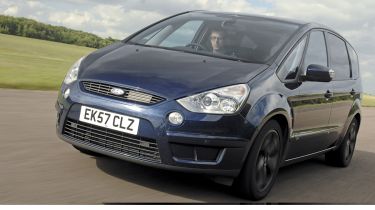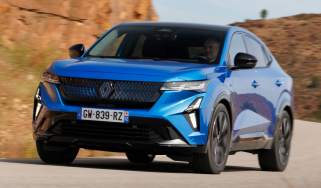Ford S-Max Titanium
Seven-seat carrier makes a strong case for itself.
Although it’s not the biggest seven-seater on the market, Ford’s S-MAX is one of our favourites. Based on the same platform as the new Mondeo, it has the dynamic abilities to match its showroom appeal. But is that enough to make it a smart choice here?
While the S-MAX has one less seat than the i800, the quality of its design couldn’t be further removed from that of the Korean. With its sharp lines and pointed nose, plus our test car’s smart black wheels, it’s a far cry from the Hyundai’s less attractive, van-like shape.
Stylists at the blue oval enjoyed a significant advantage, though, as they had one less seat to squeeze in, meaning more flexibility with the layout was possible. So the S-MAX is best regarded as a five-person vehicle with two occasional chairs neatly folded away in the boot. Try to fit seven adults on board, and space is very tight – that’s why Ford also sells the larger Galaxy.
Legroom in the second row ranges between 700 and 860mm, depending on the position of the seats, while those in the third row have 520-800mm of space. Compare these figures with those for the larger Hyundai: middle row passengers get 620-1,030mm of legroom, and occupants in the back have 590-980mm.
Luggage capacity suffers if you use all the seats – the sixth and seventh are in the boot space, leaving only 285 litres for storage. At least you can fold all five of the Ford’s rear chairs to gain a vast load area; you can’t in the i800.
The S-MAX is more expensive, but the firm manages to justify a £3,500 price premium over the Korean model on the road with even more conviction. In fact, the S-MAX proved to be one of the best cars to drive in our test. Even though it’s a family MPV, the seven-seater offers handling good enough to put many hot hatches to shame. Turning into a corner, the front wheels track neatly in, rather than push wide as in many other people carriers.
Equally important is long-distance cruising comfort – and this is another area where the seven-seater scores well. The only weakness in the package is the engine. Not only is the diesel unit a bit smoky, its performance was far from sparkling in our hands. At the test track, our best 0-60mph time was 9.8 seconds. With seven on board, we managed only 12.4 seconds.
Still, we have no complaints about the efficiency of the oil-burning powerplant. The S-MAX emits 23.4g/km per person when fully laden – that’s considerably less than any other model in this test.
Our luxuriously equipped Titanium model costs £23,045, while a new 2.2-litre flagship is available for an extra £1,000. The range starts from £18,195 for an entry-level 2.0-litre petrol variant.
Whichever version you choose, the S-MAX is one of the most accomplished MPVs around – and Ford’s stylish seven-seater could be hard to beat in this test.







